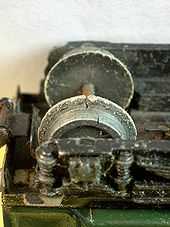Zinc pest


.jpg)
Zinc pest, (from German Zinkpest), is a destructive, intercrystalline corrosion process of zinc alloys containing lead impurities.[1] It was first discovered to be a problem in 1923.[1]
Zinc pest affects primarily die-cast zinc articles that were manufactured during the 1930s, 1940s, and early 1950s. In Germany, articles made from Zamak during World War II and several years thereafter may be affected.[2] Purer alloys were not available to the manufacturers as they were used for the war effort, or were just not on the market after the war. While impurities of the alloy seem to be the cause of the problem, environmental conditions such as high humidity (greater than 65%) may accelerate the process.[3] Also, significant temperature changes can be damaging.
Affected objects may show surface irregularities such as blisters or pitting. They expand, buckle, tear, and in the end, crumble. The irreversible process will eventually destroy the object. Due to the expansion process, attached normal material may be damaged secondarily. Zinc pest is different from a superficial white oxidation process ("Weissrost") that may affect some zinc articles.
Zinc pest is dreaded by collectors of old model trains, toys, or radios where the zinc die-cast process was used. Valuable items are rendered worthless but for their residual parts. Also parts of engines of older vehicles or airplanes and military medals may be affected.
Articles made after 1960 are generally considered free of the risk of zinc pest since the use of purer materials and more controlled manufacturing conditions make zinc pest degradation unlikely.[3] However, some model aircraft and AFV produced between 2002-2003 by certain brands have fallen victim to zinc pest.
Zinc pest is not related to tin pest.
See also
- Tin pest (chemically unrelated but similar in its progressiveness and irreversibility)
- Bronze disease (chemically unrelated but similar in its near-inexorable progressiveness and irreversibility)
References
| Wikimedia Commons has media related to Zinc pest. |
- ↑ 1.0 1.1 prepared under the direction of the ASM International Handbook Committee ; Stephen D. Cramer and Bernard S. Covino, Jr., volume editors. (2005). ASM Handbook 13B. ASM International. p. 37. ISBN 0-87170-707-1..
- ↑ "viele Geschichten, eine Lösung" (in German). Retrieved 2007-03-19.
- ↑ 3.0 3.1 J.Koll. Koll’s Preiskatalog. Band 1. 2001 Verlag Joachim Koll. ISBN 3-922164-91-9